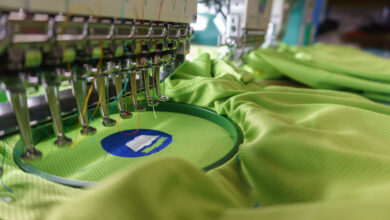In the past several months, custom graphics shops across the printing and customization industries have reported supply chain issues, including delays in shipping and unavailability of the products they need.
A smoothly operating supply chain is critical not only for suppliers but also for the businesses they serve. That trickles down into the customer experience, affecting turnaround times and getting custom products and prints in their hands.
In the video above, Vital Signs NW owner Lenny Huiras shares his shop’s experiences and how he’s managing inventory shortages. Additionally, manufacturers and distributors from around the industry share their experiences and shed some light on the delays and some information they want business owners to know.
Supply chain issues arise
Scott Sletten, president/CEO of JDS Industries, says these bottlenecks even affect the economy as a whole. He explains, “It is usually something that happens in the background and you only really hear about (it) when there are problems. Right now, there are problems with nearly all aspects of the supply chain, both within the U.S. as well as with imported products as our economy recovers.”
From shipping problems to companies not producing or supplying products, the industry has seen it all. In some cases, shipping couriers have included clauses or fine print in their promises, noting that regular delivery times aren’t promised. There’s been such a demand in shipping that companies like UPS, FedEx, and USPS struggle to keep up with the high volumes of online shopping.
Sletten offers a real example, “Here at JDS we had UPS not able to work full trucks of our daily shipments nine times in March in different locations. This causes delays in many packages, and both UPS and FedEx suspended the normal ground shipping guarantees many months ago.”
Couple the surge in shipping needs with some of the intense weather the U.S. saw early in the year, and the delays kept coming. Sletten also notes the rise in the economy, as the nation and the world recover from the COVID-19 pandemic, as a reason behind supply chain disruptions.
He adds, “There has been a huge surge in volume with the economy improving, and many trucking companies continue to struggle with lack of truck drivers as well as dealing with employees out with COVID and being quarantined. There is simply not enough capacity to meet demand right now, and that will continue to cause shipping delays and will probably not improve soon as the economy continues to get stronger, and demand only increases.”
Todd Downing, owner of Fat Dad Custom Designs and co-founder of Our Success Group, speaks on supply and demand within the apparel decorating industry. He says, “If you are an apparel decorator or personalization expert over the last year, you have experienced a shortage of some kind.”
On the apparel side of things, Downing has seen this shortage with hoodies.
“SanMar had told us that a shortage of hoodies was coming due to COVID, and we should prepare for it in early fall. When the shortage came, it was catastrophic for some as they could not offer some of their best-selling products,” he tells GRAPHICS PRO. “When fall rolls around, one of our fourth-quarter specials is hoodie packs. You buy ‘X’ amount of hoodies, and you get ‘X’ amount of T-shirts, long sleeves, and crewnecks for free.”
He knew it wasn’t looking good for his seasonal special after attempting to order from 10 different warehouses and three different vendors.
“At first, if you wanted 24 black hoodies in four different sizes, you had a good chance of getting all the same brand, but you would just have to order from different vendors or warehouses. But that quickly ended as many of the brands were completely out of stock in a certain size, so now you had to mix and match brands. This was our new reality,” says Downing.
Greg Brown, chief operating officer/president at Citadel Brands, a distributor of hoodies, sweats, jackets, and sportswear for AWDis, confirms some of these supply chain woes by sharing that “Since mid-November, the reliability of shipments coming from overseas has been very challenging. From the availability of vessels to receiving the vessel at port and unloading the containers has been abnormal to say the least.”
Citadel Brands is the exclusive North American partner of the AWDis (All We Do is) stable of brands headquartered in the U.K. Its U.S. facility in Charlotte, North Carolina, services from Texas to South Carolina and Florida to New York.
Brown adds that transportation has been its No. 1 supply chain concern, as well as delays in corrugated boxes and the reliability and quality of the boxes it uses.
M&R Printing Equipment’s executive VP Peter Walsh echoes some of Downing’s and Brown’s sentiments, as he’s heard about these issues directly from customers. He adds that supply chain management has become a big challenge for garment decorators as the later stages of the pandemic arrive.
“Our customers are reporting shortages and delayed shipments of blank garments, and/or the need to ship from multiple sites to complete an order,” he says. “Garment decorating supply distributors are likewise experiencing shortages and delayed shipment of inks and supply products.”
He shares M&R’s experiences, adding that the company is seeing shortages and increased pricing on critical raw materials it uses, like steel, aluminum, and lumber.
Just as the apparel and custom products industries were and still are affected, so is the wide-format printing industry.
Mutoh’s president and general manager, Brian Phipps, says because of the company’s strong supply chains, it’s been fortunate the last several months in that it only had to deal with some short-term challenges. It’s thankfully been able to work those out with customers.
“Unfortunately, regarding the overall print industry, not everyone has been so fortunate. We have heard about different struggles of printing companies and suppliers having a difficult time getting printers, ink, parts, and media for various supply chain reasons,” he adds.
So, what’s behind all the holdups? Sources have some answers to what’s happening and how to deal with these issues.
Causes of supply chain disruptions and their effects
When COVID-19 first started affecting the industry, factories, manufacturers, and print service providers (PSPs) were shut down for the health and safety of their workers, plus the slowdown in business.
With shutdowns and job loss, the industry turned to online buying, much like the rest of the world’s industries. The surge in online buying meant a demand for products, and as Brown puts it, “inventories got depleted.”
“Then when the markets started to open back up, and orders started flowing again, a backlog built up quickly,” Phipps explains. “We all have become so used to getting our orders ‘just in time’ and that all changed for us last year during the pandemic.”
For many manufacturers and suppliers, capacity couldn’t keep up with demand, and shipping couldn’t keep up with the number of orders requiring delivery. According to Brown, the lack of workers on vessels, crane operators at ports, and truck drivers to make deliveries also impacts supply chains and delivery times.
More specifically, for wide-format printers over the last year, sourcing inks has been an issue. Phipps explains that although Mutoh has seen minimal impacts in this department, in general, some materials and components needed to create inks, like pigments and carriers, have seen supply interruptions.
He adds, “When people start to see shortages happening, then they typically start to order extra, and that can make the problem worse.” Many in the U.S. saw this first-hand at their local grocery stores – with shortages of necessities like toilet paper and food items.
“If everyone starts ordering double to triple what they normally do, it puts more pressure on the supply, causing outages faster than normal,” Phipps explains. “That combined with shipping delays, it becomes the perfect storm for shortages.”
Sletten sheds some light on the seriousness of the issues by sharing some numbers: “In 2019, it took an average of five weeks from the time a container left a factory overseas to be at our dock. The average time right now is running closer to eight weeks.”
Containers aren’t getting delivered and emptied at their normal pace, and thus not returning quickly to factories to be refilled again with product. Sletten says this slow in the chain causes factories to have to store finished products – something they didn’t previously need to do. Then, once storage is full, they must slow down production due to lack of space for finished products, and it becomes a cycle of disruption.
“As the economy is getting stronger and companies are only ordering more product, these problems are not likely to get better in the next few months,” he adds.
And product shortage and delays aren’t the only direct effects. Supply chain issues and shortages start to affect product price and staffing. For example, most of AWDis garments are “cotton-rich,” according to Brown, and cotton prices have increased. He also says staffing has been a significant issue, with workers hard to come by.
“The last 15 months have drastically changed the workforce attitudes,” he explains. “We have offered bonuses to come to work, and all the OT wanted, and still no one wants to come to work consistently.”
Sletten says JDS has seen price increases from around the world, and it’s doing what it can to minimize changes and delays for its customers in hopes some normalcy will come in a few months.
“2021 is going to be a year of great recovery in our economy, but this surge in demand is going to lead to some price increases as well as product shortages,” he states. For PSPs and personalized product providers, that means costs increase.
Phipps also offers some insight on the price topic, adding that with supply and demand, “There is always pricing pressure to increase prices when supply is short. But that is only because all the costs along the way have increased. Because the demand is so high to get products here from overseas, shipping costs have exploded. Manufacturing costs go up, freight costs rise, and then demand, it can even create a bidding war in some cases. We see that in the housing market right now, for example, in some areas of the country.”
Sources agree it’s a ripple effect that starts at product production and trickles down to how and what shops can offer.
What now
Only time will tell how much longer manufacturers, suppliers, and shops will be affected by these disruptions, but the industry experts have some predictions about capacity and demand and some hopeful words for print and personalization business owners.
Sletten says these types of issues have “a way of self-correcting over time,” and he expects that’ll be true in this case. Whether it takes six months or an entire year, he assures that certain products will get back into balance sooner than some others. He adds that suppliers and manufacturers will have more stock once this initial surge in demand levels out.
Downing says customers still want their custom products no matter the issues, which means retailers and print shops need to have transparent conversations and be honest, something Huiras, Vital Signs NW, also points out. They encourage other shops to give customers a heads up on any issues they might run into with an order.
Downing uses the toilet paper shortage as an example with customers — how that looked and how that began to balance out. “We told them about the shutdowns overseas, the ships sitting in ports, import companies working at one-fourth of the staff, and how that all meant that we just didn’t know anything, but as soon as we could, we would.”
Giving customers a heads up on lead times and supplier in-stock dates doesn’t hurt either, with the understanding that some customers just won’t be willing to wait. Downing continues, “Now, we also had to let them know that it was an estimate as no one knew for sure until the product was in hand. Slowly items started coming back in stock, and a lot of times, as soon as an item came back in stock, it was gone again. It sort of became an exciting game of ‘Can I place this order before it goes out of stock again?’”
Today, the shop is getting back to orders without issue, and Downing says customers it was able to serve in those tumultuous times are happy and thankful. The customers it couldn’t help understood due to full transparency.
“At the end of the day, it’s all we can do; be as informative to your customers as possible,” he adds, “Educate them on why something will or won’t work, what the different print methods are, and the difference in material blends. A better-educated customer means less time answering questions and more time making money.”
Sletten echoes the same points, noting that retailers need to bring honesty to their customers and help them make informed decisions, like placing orders much earlier than usual.
“To wait until right before an event to order is going to be more risky over the next six months,” he explains. “Pricing is likely to go up on some items as well, so you can encourage customers to order early to lock in current prices as well. Perhaps get a deposit on an advance order so you can bring in the products, and they personalize them later as needed.”
Aside from educating customers and opening the transparency door, Michael Johnson, director of marketing for Hanes Activewear, says partnering with suppliers that can help you navigate issues like these is best.
“It’s vital to have visibility and to really understand your supply chain,” Johnson argues. “What you don’t know can be catastrophic for your business. Whether it’s a pandemic, a natural disaster, environmental or labor abuses, or a shipping blockade, there is always some level of vulnerability. Companies make decisions every day regarding their level of exposure, weighing risks against cost savings or speed to market. Make the smart, ethical choice.”
Whether you found comfort in knowing you’re not alone or gained a certain level of understanding, we hope this deep dive helps you navigate supply chain disruptions happening within the custom graphics industry, or even within your personal life.




